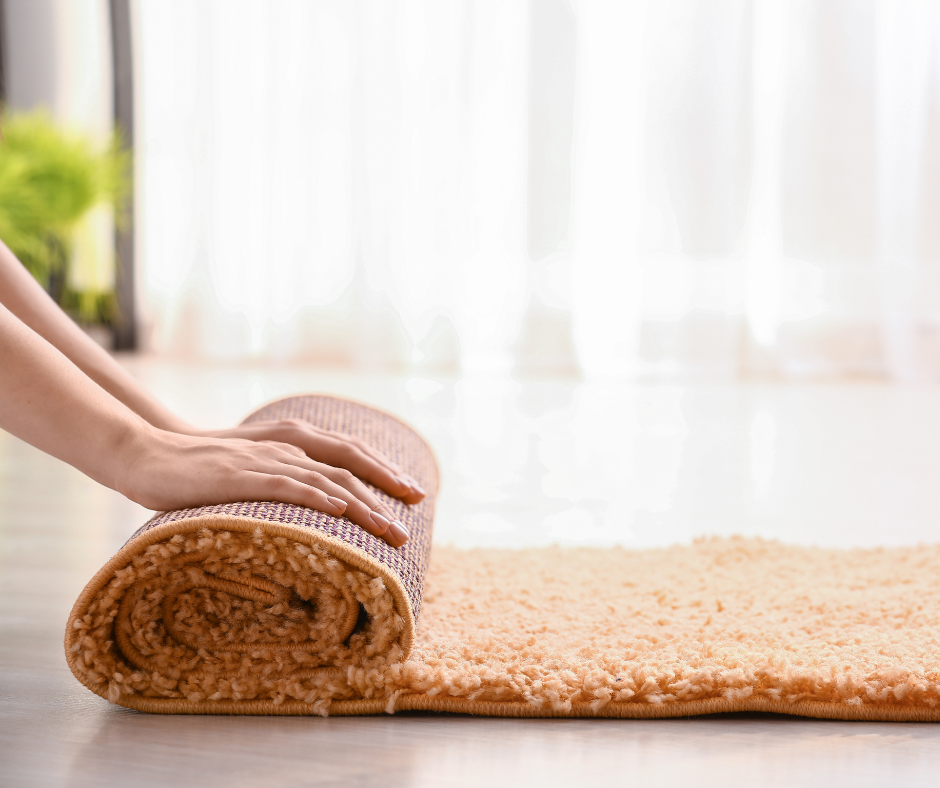Sounds on the floor occur when the material expands and contracts. The noise originates from the materials bumping against other pieces of the floorboard. Humidity enlarges flooring during the summer and contracts it in the winter. Eventually, the continued back-and-forth stretching will rip flooring and floorboards apart.
The most common squeaky floor sounds come from hardwood floors. Tile, laminate, bamboo, ceramic, and porcelain flooring have this issue, too. It’s less common in vinyl, carpet, and cork flooring, but still possible as a result of poor installation or extreme humidity.
So, can rugs help squeaky floors? It is not a permanent solution, but a rug can help. However, it’s all about choosing the right rug type. Choosing the wrong rug type will worsen the squeaking sound.
In This Article We'll Discuss
Can Rugs Help Squeaky Floors?

The simple answer is yes.
Rugs can help reduce the squeaky flooring noise. They will make it so that your floor isn’t a distraction during the day or a disturbance at night. However, the rug won’t do any good if you place it in the wrong area, so be sure to position it directly on top of the squeaky noise.
Rugs work for squeaky floors on second-story and multi-story floors. That includes homes, apartments, lofts, townhouses, and condos. The rug will absorb noise, so no one downstairs will hear your every move. Rugs also absorb vibrations from sounds and echoes.
Of the many home hacks to reduce squeaky floors, rugs are a budget-friendly solution. It is also a very simple solution since you can cover the floor and forget about it.
Will My Floor Squeak Under a Rug?
Sadly, rugs are not a lasting solution. They cover the problem up instead of solving it, so you may still hear a noise when you step on the rug. Only a flooring expert can fix the issue and make the squeaking disappear forever. There are also DIY solutions on the internet, but those solutions are temporary, too.
What rugs do is muffle the sound of squeaky flooring. So, the loud, squeaky noise you hear when you step on it will be less noticeable. While it doesn’t get rid of the noise entirely, a reduced or muffled sound is better than hearing the squeaking noise at its highest volume.
Do Thick Rugs Help with Squeaky Floors?
A thick rug is better for squeaky floors than thin rugs. Thick rugs have padding that absorbs sound and decreases floor pressure. Bodyweight pressure transfers from the source onto the thick rug. That helps with the squeaky sound.
Thin rugs don’t have enough layers to absorb sound and pressure, but thicker rugs do. The sewing construction is also not as tight as thick rugs. That’s why you continue to hear the squeaky sound even with a rug on top of it.
Thin rugs encourage floor tile, boards, and pieces to move around more. These rugs are also too flat to catch sound coming from the floor. So, if your only option is a thin rug, you are better off dealing with the squeaky floor. But, a thick rug should definitely help.
Which Rug Materials Will Help the Most with a Squeaky Floor?
It is not enough to just buy a rug and cover the squeaky spot. Buying the right rug type is imperative. You know to concentrate on thick rugs, but which rug material reduces noise on squeaky floors? These 8 rug materials are the best for reducing noise:
- Carpet
- Cotton
- Felt
- Fur
- Jute
- Shag
- Sisal
- Wool
The rugs listed are not only thick and fluffy in appearance, but they’re well-constructed. That drowns out squeaky floor noises with ease.
An alternative rug material to try is flokati— a Greek type of wool. You can also mix and match rug materials on the list, as it is rare to buy a 100% pure rug. Rug size doesn’t matter when it comes to squeaky floors, as long as it is large enough to cover the sound.
Will Adding a Rug Pad Also Help to Reduce the Noise?

Absorption pads or rug pads stop rugs from sliding around the room. Without them, rugs can slide from under you, causing accidents and injury. Corner grippers can also stop rugs from moving, but they don’t absorb sound.
What makes absorption pads unique is their sound-absorbing properties. Rug pads block a lot of sound before it even reaches the rug. The rug then only has to muffle the sound that leaks through the pads.
After placing the rug pad on top of the squeaky area, place the rug on top. A rug pad gives thin rugs a sound-absorbing barrier but doubles the sound-absorbing abilities of thick rugs. The result reduces the annoying squeaky floor sound so that it’s almost non-existence.
Conclusion
When flooring material expands, it creates a squeaky sound. Usually, this is a seasonal issue, but if it lasts year-round, you’ll need expert repair.
Remember, rugs can help, but they’re not a permanent fix. Contact an expert to resolve the squeaky issue forever. Share your experiences in the comment box about finding the perfect noise-canceling rug. Also, spread this information on your social media network.

